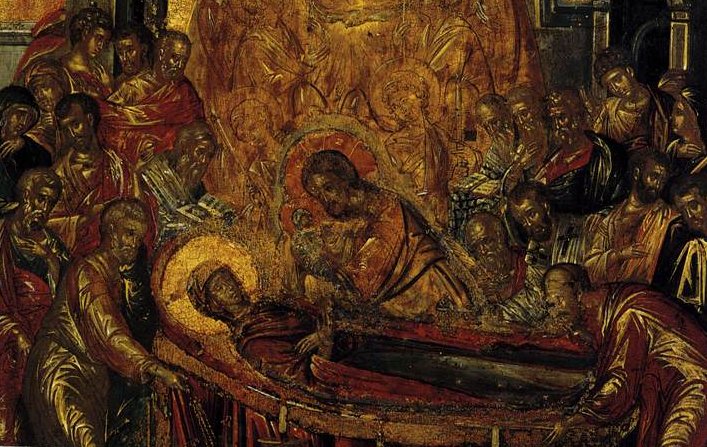Solemnity of Mary's Assumption (15Aug2008) Rv 11.19a, 12.1-6a,10ab; Ps 45; 1Co 15. 20-27; Lk 1. 39-56
Homily of Rev. Paul D. Panaretos, S.J.
Virgin Mary and Grammar of Faith
Homily of Rev. Paul D. Panaretos, S.J.
Virgin Mary and Grammar of Faith
Our Catholic faith seeks to know the truth. In its search for truth the grammar of our faith can best be described as both-and rather than either-or. The both-and of faith often frustrates us. We may use its both-and grammar--
- divine & human;
- one divine nature & three persons;
- Almighty Creator & Loving Father;
- Son of God & Son of Mary;
- Mother of God & Mother of Jesus;
- made holy by God’s Spirit & in need of ongoing reform;
- prayer & action;
- religion & science;
- creation & evolution;
- faith & reason--
 The gospel on this day that we honor Mary as the first human to enjoy the destiny God desires for all people features both-and. In fact, the selection used at this mass, which we have come to designate as the Visitation, immediately follows her Annunciation, God’s announcement
The gospel on this day that we honor Mary as the first human to enjoy the destiny God desires for all people features both-and. In fact, the selection used at this mass, which we have come to designate as the Visitation, immediately follows her Annunciation, God’s announcement that Mary would be the mother of God: The holy Spirit will come upon you, and the power of the Most High will overshadow you. Therefore the child to be born will be called holy, the Son of God./1/
Mary’s encounter with the holy in that moment was nothing less than arresting. Numerous artistic renditions of Mary’s encounter evoke timelessness in time, and they still the mayhem of the mundane. You and I may remain in awe of Mary’s let it be done to me as you say./2/ Mary did not remain in it at all; she set out and traveled to the hill country in haste to a town of Judah, where she entered the house of Zechariah and greeted Elizabeth.
Mary modeled for us both-and: she roused herself from timelessness and inserted herself in the present; she was overwhelmed by awe and acted in deed and word to see what God had done already in her kinswoman and to attend to her needs. Her movement from home to home and the simplicity of her words of praise remind us that as awesome and all-powerful our God is, God is not distant nor inaccessible. In addition to God’s magnificence, God also abides in human hearts and homes and in the care and concern we offer each other and those most in need.
Mary enacted her willingness to be slave of her Lord by putting herself at the disposal of Elizabeth. Both the woman who served and the woman who received caring attention praised God. While Mary did not at that moment give birth to her Lord, she brought him to life by her tender care showered on Elizabeth. By an angel God announced Mary would mother the Most High into the world; and to Elizabeth Mary already gave bodily expression to the lowliness--the mercy--of the Most High.
 Before God walked as Jesus, both divine and human, Mary conceived by God’s Spirit and gave him a different sort of birth by her own compassionate actions. Mary models for us our present share in the reality of the kingdom her Son has prepared for us. Present & future is yet another both-and of our grammar of faith. Present and future calls us to live and act our future destiny as we struggle in our present, which so often refuses to exalt the lowliness of Mary’s Son, our Brother and God. Our world desperately needs us to live that truth, which we know: the lowliness of our Most High Savior and brother.
Before God walked as Jesus, both divine and human, Mary conceived by God’s Spirit and gave him a different sort of birth by her own compassionate actions. Mary models for us our present share in the reality of the kingdom her Son has prepared for us. Present & future is yet another both-and of our grammar of faith. Present and future calls us to live and act our future destiny as we struggle in our present, which so often refuses to exalt the lowliness of Mary’s Son, our Brother and God. Our world desperately needs us to live that truth, which we know: the lowliness of our Most High Savior and brother.______________
1. Luke 1.35.
2. Luke 1.38.
____________________________________________
Wiki-images of Broedelam's diptych of Annunciation and Visitation and El Greco's Dormition are in the public domain.
No comments:
Post a Comment